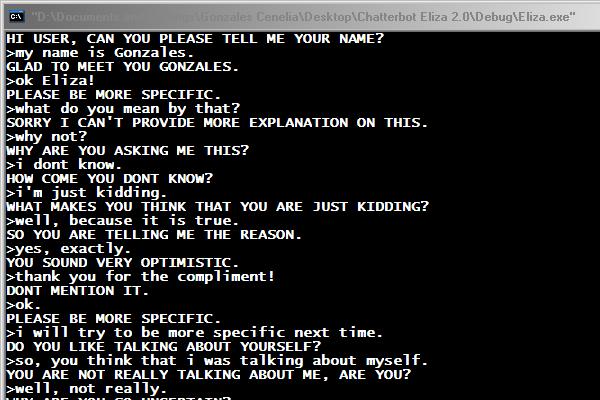I remember, as a kid, having several books of BASIC programs, mostly games, that I could dutifully type into my IBM PC, save on a a floppy to play again and again. One of them, which I remember intrigued me at the time, was called Eliza, which according to Wikipedia, is
a computer program and an early example of primitive natural language processing. ELIZA operated by processing users’ responses to scripts, the most famous of which was DOCTOR, a simulation of a Rogerian psychotherapist. Using almost no information about human thought or emotion, DOCTOR sometimes provided a startlingly human-like interaction. ELIZA was written at MIT by Joseph Weizenbaumbetween 1964 and 1966.
The outcome would look something like this:

The implicit joke at work with Eliza is that one of the easiest conversational models to simulate would be that of the classic psychoanalyst, the content of whose speech is (proverbially) meant to be meaningless. Rather it’s only the reflective form of the speech (“Can you elaborate on that?” “What do you mean by that?”) that matters. The therapist turns every statement of the patient’s into an opportunity to ask another question – and in particular meta-questions about the meaning of the meaning. (“Do you like talking about yourself?”)
The video at the top of the post is a pitch from a company called Nuance, best known for its Dragon speech-recognition software, to develop voice-recognition and -response driven ads for mobile devices. Of course, most of us are all too-familiar with this sort of mechanical conversation from dealing with our banks and utilities, as installing a robot to hear and respond to us, find us the department that we need to be in touch with (or, more often it seems to me, find a way of confusing us away from the proper department).
But what seems to me interesting, however, about all of this is the way that the things I’ve posted above relate to one another. (Of course, there are several famous episodes in the history of advertising that render the relationshop between it and psychoanalysis rather clear, starting with the fact that the “father of modern public relations,” Edward Bernays, was Sigmund Freud’s nephew, and certainly wasn’t afraid to bring his uncle’s ideas to bear upon his own work.) Listen to the Nuance video again. It seems to me significant – even (we might almost say) psychoanalytically significant – that in both of the “sample” applications of their software, the computer-driven voice digresses into pseudo-therapeutic responses on its way to the delivery of the product message. In the case of the florist ad, it’s the “Of course you don’t!” as an answer to the revelation of the husband’s ignorance, whereas in the deodorant pitch, it’s the bizarrely chirpy wish-fulfilment about “This is America.”
What else, in the end, is a computer going to do as it makes conversation with us, other than provide a pseudo-therapeutic sounding board? But given that that’s the “selling point” of the technology on offer, it’s almost as if the ultimate point of the ad – the delivery of the commercial message – comes as a non sequitur interruption, rather than the other way around, as is especially clear in the deodorant ad above (“And while you’re at it…”). After all, it’s not the ability to deliver the product pitch that the company is selling as an innovation. It’s the calming but uncanny banter that is meant to disinhibit the potential consumer, to get her or him to “open up” the mind and ultimately the wallet.
It’s hard not to see Nuance’s sample responses, driven we might imagine by conversational algorithms not vastly more complicated than ELIZA’s, as subtly demonstrating the deep formal relationship between the two modes of discourse at play. So, on the one hand, the computerized conversations above gesture towards the sort of content-free “idle talk” that characterises certain versions of therapeutic discourse. On the other – and of more interest to me – the form of the Nuance exercise also reflects the deep affinities of advertising with psychoanalysis, as both quest for a) an understanding of what the patient/customer “really wants” and b) a means to spur the patient/customer on to the fulfilment of that want.
At any rate, as some of you might guess, I am going to try to get some work done this summer on my long-deferred “advertising” project. True to this post, what is of most interest to me is the strange relationship between the functional and aesthetic aspects of advertising – i.e. an analysis of the parts of advertising that aren’t the direct product pitch, the announcement of details / utility / price. In a sense, we’re used to moving in the other direction in our considerations of the “aesthetic.” That is, we find a case of it and then we work to show the material underpinnings of its emergence. Advertising forces us to work the other way around. We take the functionality of the work as primary, but then its all of the supplementary, ostensibly not-directly-functional elements that stand as a mysterious remainder. (As you might further guess, the project would be reflexively anti-Adornoian from the start. Or maybe that’s not the right way to put it. It’s bound up with this thinking, put attempts to walk the path in the other direction. Or perhaps in the same direction, but backwards…) We intuitively understand, in other words, that they want to sell us deodorant. The question is why they and we need the conversation with the computer in order for them to do that.



















